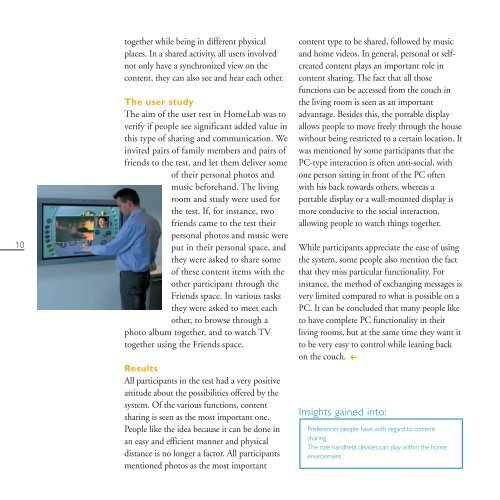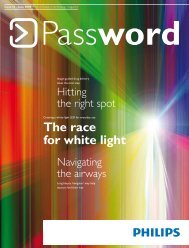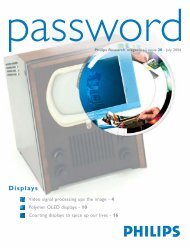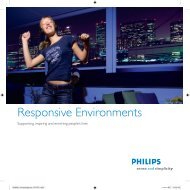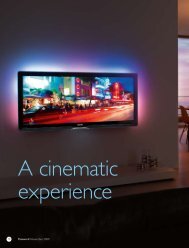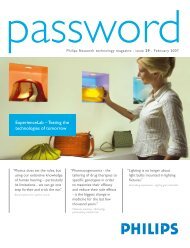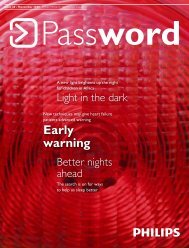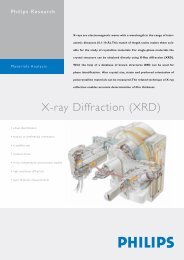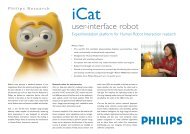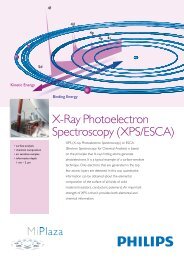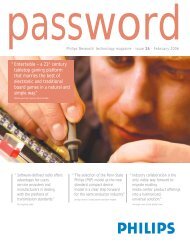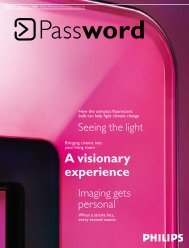365 DAYS AMBIENT INTELLIGENCE IN HOMELAB - Philips Research
365 DAYS AMBIENT INTELLIGENCE IN HOMELAB - Philips Research
365 DAYS AMBIENT INTELLIGENCE IN HOMELAB - Philips Research
You also want an ePaper? Increase the reach of your titles
YUMPU automatically turns print PDFs into web optimized ePapers that Google loves.
Ambient 05-05-2003 12:36 Pagina 10<br />
10<br />
together while being in different physical<br />
places. In a shared activity, all users involved<br />
not only have a synchronized view on the<br />
content, they can also see and hear each other.<br />
The user study<br />
The aim of the user test in HomeLab was to<br />
verify if people see significant added value in<br />
this type of sharing and communication. We<br />
invited pairs of family members and pairs of<br />
friends to the test, and let them deliver some<br />
of their personal photos and<br />
music beforehand. The living<br />
room and study were used for<br />
the test. If, for instance, two<br />
friends came to the test their<br />
personal photos and music were<br />
put in their personal space, and<br />
they were asked to share some<br />
of these content items with the<br />
other participant through the<br />
Friends space. In various tasks<br />
they were asked to meet each<br />
other, to browse through a<br />
photo album together, and to watch TV<br />
together using the Friends space.<br />
Results<br />
All participants in the test had a very positive<br />
attitude about the possibilities offered by the<br />
system. Of the various functions, content<br />
sharing is seen as the most important one.<br />
People like the idea because it can be done in<br />
an easy and efficient manner and physical<br />
distance is no longer a factor. All participants<br />
mentioned photos as the most important<br />
content type to be shared, followed by music<br />
and home videos. In general, personal or selfcreated<br />
content plays an important role in<br />
content sharing. The fact that all those<br />
functions can be accessed from the couch in<br />
the living room is seen as an important<br />
advantage. Besides this, the portable display<br />
allows people to move freely through the house<br />
without being restricted to a certain location. It<br />
was mentioned by some participants that the<br />
PC-type interaction is often anti-social, with<br />
one person sitting in front of the PC often<br />
with his back towards others, whereas a<br />
portable display or a wall-mounted display is<br />
more conducive to the social interaction,<br />
allowing people to watch things together.<br />
While participants appreciate the ease of using<br />
the system, some people also mention the fact<br />
that they miss particular functionality. For<br />
instance, the method of exchanging messages is<br />
very limited compared to what is possible on a<br />
PC. It can be concluded that many people like<br />
to have complete PC functionality in their<br />
living rooms, but at the same time they want it<br />
to be very easy to control while leaning back<br />
on the couch.<br />
➜<br />
Insights gained into:<br />
Preferences people have with regard to content<br />
sharing<br />
The role handheld devices can play within the home<br />
environment


